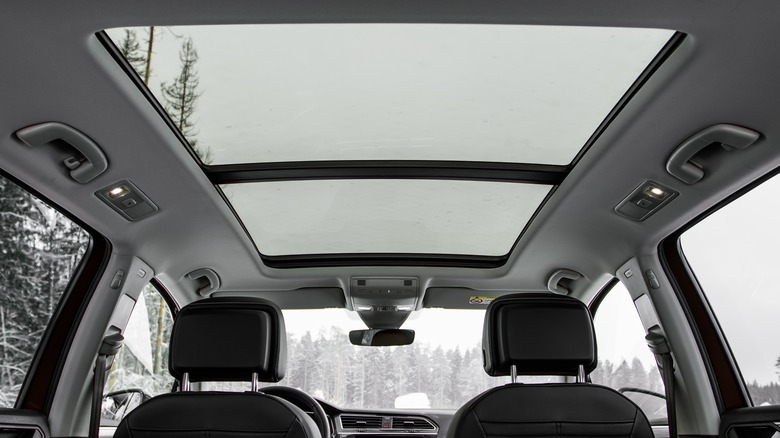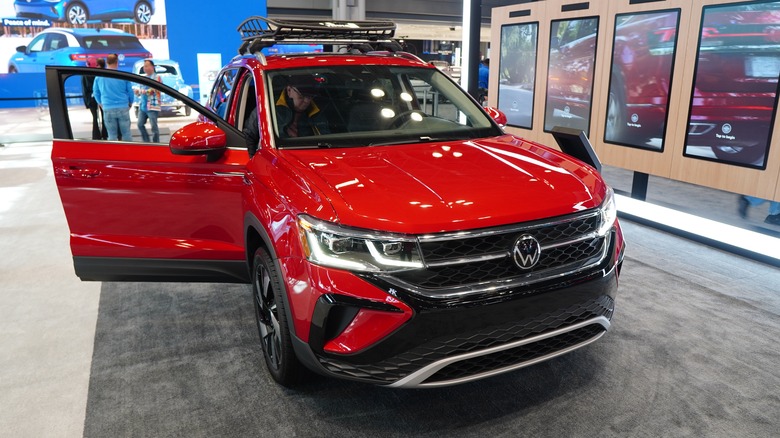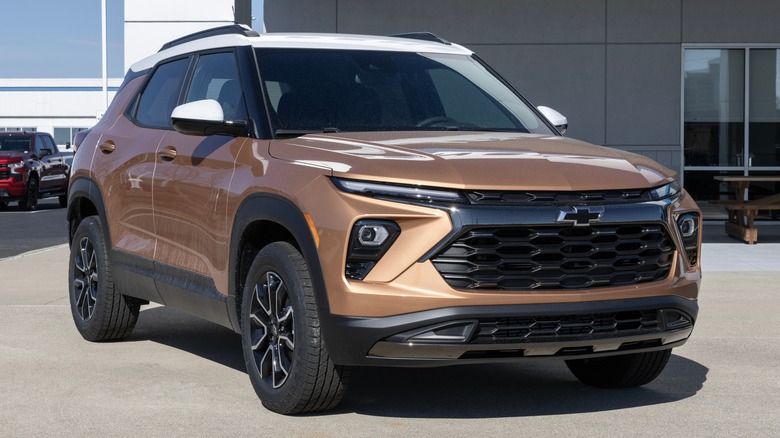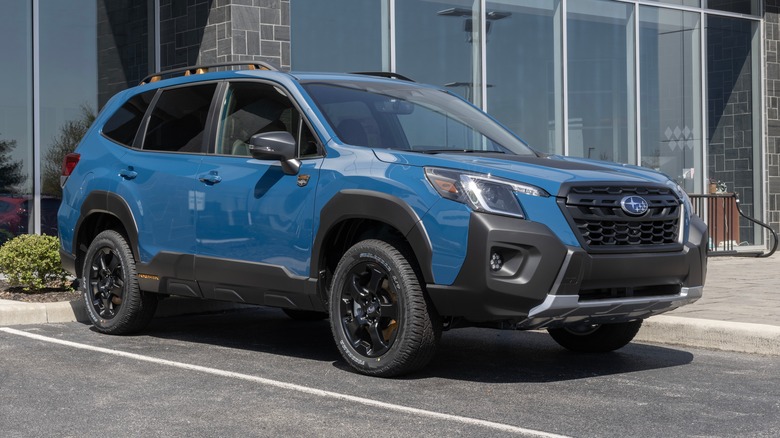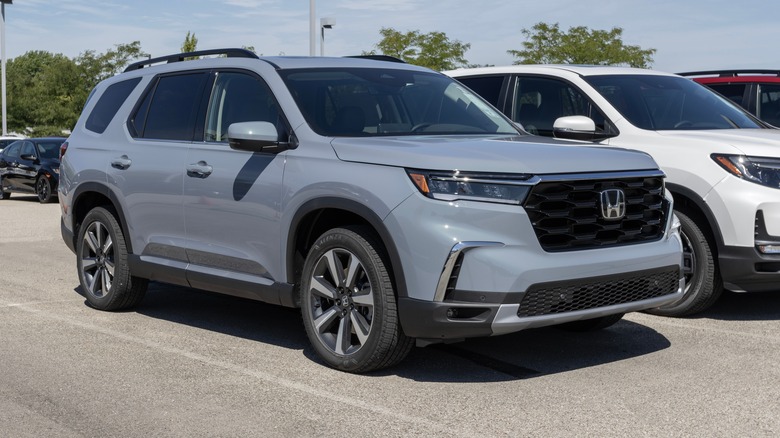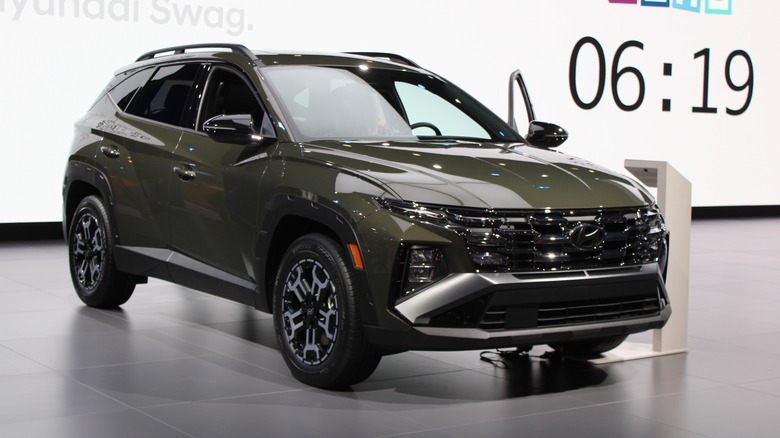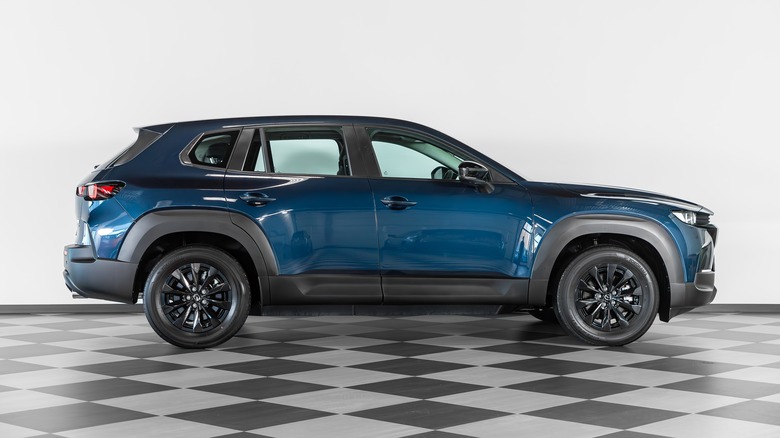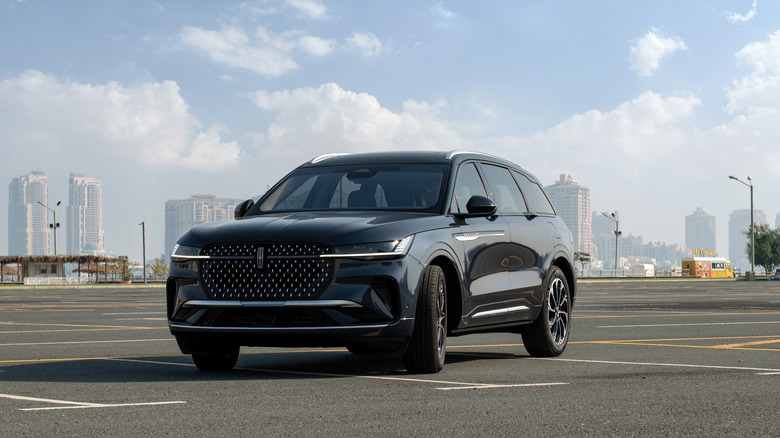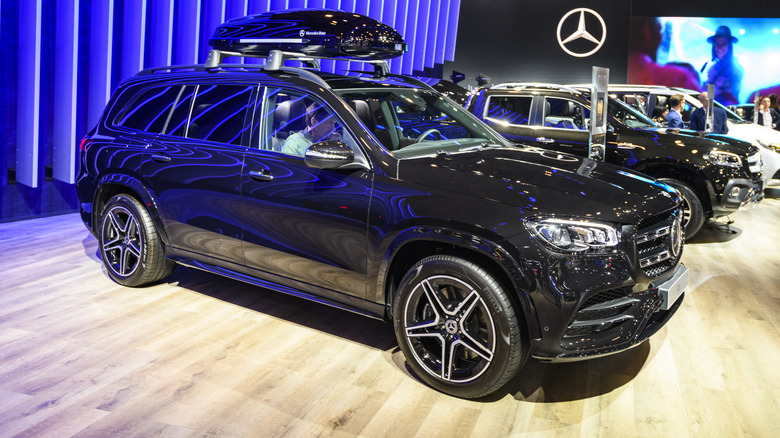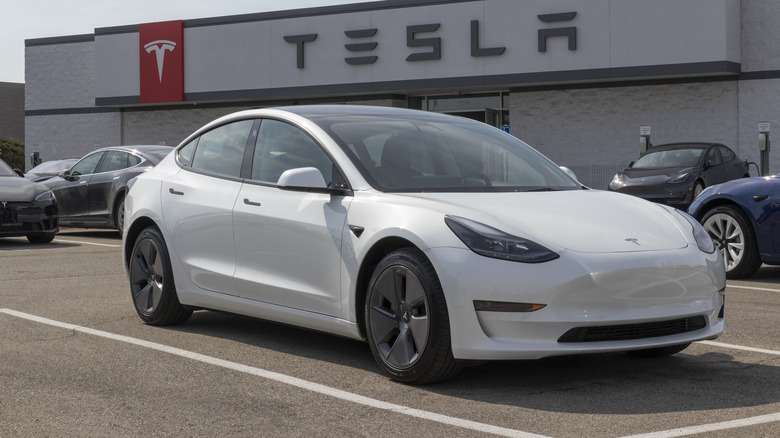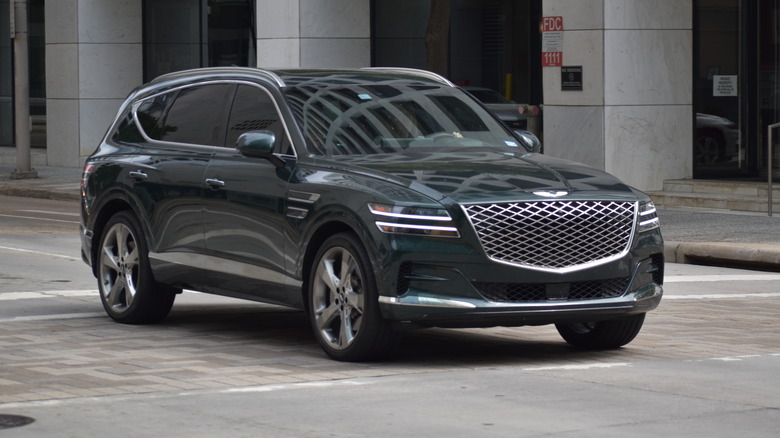10 Of The Best SUVs With Panoramic Sunroofs In 2024
Once upon a time, cars didn't have real roofs. Early automakers would cover the interior with a canvas top or other material to help keep out the elements. Those tops were retractable in some cases, which technically serve as the first examples sunroofs. It wasn't until Cadillac put a fully enclosed roof on a car in 1905 that solidified how cars should be made. In the 1920s through the 1940s, manually retractable metal and vinyl panels became trendy among upmarket automobile owners, giving history its second type of sunroof.
It was until Lincoln in the 1950s that the automatically retractable glass sunroof became a thing. Initially, it was a dealer-installed option that added an integrated glass panel to the roof controlled by electronic switches within the cabin. As tempered glass became more common, automakers started offering retractable glass sunroofs on their vehicles. The rest, as they say, is history.
Somewhat surprisingly, panoramic sunroofs are also fairly old. Lincoln debuted the Lincoln XL-500 Concept Car in 1953 that featured a nearly entirely glass top, even if it was technically plexiglass. Over the last decade, automakers have begun popping panoramic roofs — sometimes called pano roofs — onto their vehicles to add a touch of luxury and airiness. You can't hit a golf ball without hitting a car or an SUV that potentially comes equipped with a panoramic sunroof these days, so here are the best ones to help narrow your shopping down.
2024 Volkswagen Taos
The Volkswagen Taos is a good start if you're looking for a panoramic sunroof in a smaller SUV. It's on the larger side of the subcompact crossover segment, so if you want something that takes up the same parking space as a car but want the ground clearance and all-wheel drive of an SUV, the Taos checks all of those boxes. The German automaker does what most car makers do and reserves the Taos' panoramic sunroof for the top trim, which starts at $33,515.
You do get quite a bit of car for your money. Volkswagen offers all-wheel drive on every trim level and all models include the same 1.5-liter four-cylinder engine that puts out 158 hp and 184 lb.-ft of torque. Despite the numbers, the Taos is reasonably with a zero to 60 mph sprint of 7.8 seconds. That's not going to win any drag races, but you shouldn't have any problems merging onto the freeway. There isn't a hybrid variant as of this writing, so the gas powerplant is your only option for now.
Some reviewers note that the ride can be a little firm on occasion, but the interior is otherwise spacious and comfortable. It features good visibility, generous passenger space for its size, decent storage, and enough USB-C ports for your passengers. In terms of design, the Taos may not turn heads but that can be an advantage for some people.
2024 Chevy Trailblazer
The Chevy Trailblazer is another small SUV for people who prefer American automakers. Chevy approaches the pano sunroof a bit differently than others. You can opt to include the sunroof on any trim aside from the base LS. Chevy requires you to include the Driver Confidence Package and the LT Cold Weather Package before you can add the sunroof but even with all of that, it ends up being one of the least expensive SUVs with a panoramic sunroof at just a hair over $29,000 before taxes.
Aside from its customizability and aggressive pressing, there's a lot to like about the Trailblazer. It's fairly spacious for a car its size and the 1.3-liter engine with all-wheel drive can put out 28 mpg combined, which is pretty good for an SUV that isn't a hybrid. The trade-off for that is a slightly slower acceleration speed. With that said, the Trailblazer can make it to 60 mph in a little over nine seconds, so freeway merging should be fine. You may need to plan ahead a bit to pass someone, though.
Inside the car, the Trailblazer looks modern, with a large infotainment display. Similarly, the exterior looks stylish, especially if you opt for a model that has a contrasting roof. None of the Trailblazer models come with the panoramic roof as standard, but you'll likely see them included more on dealerships with higher end trims like the Activ as opposed to the middle trims like the LT or RS.
2025 Subaru Forester
Where Chevy gives you the option for a panoramic sunroof on any trim level, Subaru makes it much easier on the Forester. All models except the base trim come with a pano roof as standard equipment. That means you can pick up a Forester for as little as $31,995 before tax and get yourself a roof that lets the sunshine in. For the most part, going up to higher trims affords more luxuries like leather seats, larger wheels, and other niceties. Subaru putting the pano roof on nearly all of its Forester models is definitely a unique approach compared to most.
The Subaru Forester is a pretty nice SUV as well. The styling is fairly aggressive as all models are clad in trim plastic that nicely offsets the paint job in most cases. For the newest models, Subaru went a bit more upmarket with the interior space with some nicer materials and contrasting pieces to keep the inside from looking too drab. Under the hood is one of Subaru's classic flat-four boxer engines. This one is a 2.5-liter that produces 180 hp and 178 lb.-ft of torque. It pushes the Forester to 60 mph in about eight to nine seconds, which is very reasonable for this class.
Perhaps the strongest part of the Forester is its comfort. Most reviews say that it rides pretty smoothly with a quiet cabin and supportive seats. Most Foresters also come with niceties like heated seats out of the gate, so there are some extra comfort benefits there. You can also double the tow rating to 3,000 pounds if you opt for the Wilderness trim.
2024 Honda Pilot
The Honda Pilot has the distinction of being the largest SUV that Honda makes, and it's also a good SUV. It also comes with a panoramic sunroof, although only on certain trims. According to Honda's Pilot webpage, the Touring, Elite, and Black Edition trims are the only two that come with a pano roof, and it doesn't appear to be available with any optional packages. That means you'll have to spend a pretty penny for a decked-out Pilot as the Touring trim starts at $47,200 for the 2025 model year.
Fortunately, it'll be money well spend because the Pilot comes with all sorts of goodies. It's a three-row crossover with optional all-wheel drive. All models come with Honda's very competent 3.5-liter V6 engine that makes 285 horsepower and 262 lb.-ft of torque. The Pilot gets to 60 mph in 7.2 seconds, which is quite good for a three-row SUV. Reviewers also note that the Pilot's drivetrain is refined, and drivers won't have a lot of jerking or weird behavior. All models of the Pilot with a panoramic roof also come with a Bose sound system, LED lights, and tri-zone automatic climate control.
The Pilot not only has a handsome exterior but a good-looking interior as well. There is a tablet-style infotainment display in the center stack along with physical climate controls and plenty of storage space. Unlike some other Honda models, the Pilot comes with ventilated seats in higher trims, a boon in the summer. There really isn't much wrong with it although there are a few things you may want to know if you plan to buy one.
2024 Hyundai Tucson and Kia Sportage
The Hyundai Tucson and Kia Sportage are listed together here because they are stablemates in the Hyundai-Kia lineup. They are based on the same platform and share more components than not. That includes the brand's panoramic sunroof, which is available on both vehicles. For the Tucson, it's available on trims as low as the SEL with the Convenience package included. The Kia Sportage has it available on the X-Line AWD trim and then it comes as standard on the SX trim or higher. That means you can get the panoramic sunroof in either vehicle around the $35,000 range in terms of pricing.
Both vehicles share drivetrains, so you'll get similar performance out of each. Stock on each one is a 2.5-liter four-cylinder engine that outputs 187 hp and 178 lb.-ft of torque. It'll mosey either vehicle to 60 MPH eventually, usually around nine or 10 seconds. Most reviewers agree that the hybrid powertrain is the one to go with as it grants better fuel economy and 40 extra horsepower. It gets either vehicle to 60 mph approximately two to three seconds faster and is definitely worth the extra cost.
Their vehicles are both stylish inside and out along with very long warranties that help offset reliability fears. Since both vehicles have the same drivetrains and are built on a similar platform, you should choose the one you like more in terms of exterior and interior styling since everything else is basically the same.
2024 Mazda CX-50
The Mazda CX-50 is a relatively new nameplate. Mazda announced the new SUV in 2021 and it's Mazda's attempt to jump into the rugged crossover market. It's designed to take on the likes of Subaru, the Ford Bronco, and other such vehicles. Mazda has a ton of trim levels with the CX-50 and more than half of them come standard with a panoramic sunroof. The included trims are the Premium, Premium Plus, Turbo, Turbo Meridian Edition, Turbo Premium, and Turbo Premium Plus. The lowest trim with the pano roof starts at $34,000 even.
Mazda tells two stories with the CX-50. The first is with the base engine. It's a 2.5-liter 187-hp engine that will move the CX-50 around at decent speeds but isn't anything special. Upgrading to the turbo engine grants you 256 hp, which introduces more urgency in the CX-50. The turbo engine is the winner for sure if you can afford it, although the regular 2.5-liter engine is still plenty peppy for everyday driving. As per the norm with Mazda, the handling is excellent for a crossover and the car is fun to drive.
Of course, the same suspension that make the CX-50 a fun ride also means it's a bit firmer than some other SUVs in the class. Other than that, the seats are comfortable, and the cabin is a generally good place to spend your time. Fuel economy is just okay, but 25 MPG combined with the turbo engine is better than SUVs used to get out of similarly powerful engines. In short, the CX-50 is a good SUV.
2024 Lincoln Nautilus
The Lincoln Nautilus takes us a step up in both price and luxury. Interestingly, the SUV doesn't come standard with a panoramic sunroof, even at its starting MSRP of $50,415. Stepping up to the Premiere II trim will grant you the privilege along with a handful of other upgraded technology. There are only two additional trims with the Nautilus. They are the Reserve, which starts at $54,850 and the much pricier Black Label that starts at $74,350.
All trim levels start with a 2.0-liter, four-cylinder engine that makes 250 horsepower and 275 lb.-ft of torque. It propels the SUV forward to 60 MPH in about seven seconds. If you can afford it, the hybrid drivetrain steps it up a bit to 310 horsepower and it shaves about a half second off of the zero to 60 MPH time. Curiously, reviewers have noted that the fuel economy is similar between the gas-only and hybrid powertrains. Other than the engines, you'll be treated to an absurd amount of technology, ambient lighting, and even scent cartridges in the center armrest that freshen the air in the cabin.
Perhaps the most breathtaking feature is the screen in the dashboard. It quite literally spans from where gauge cluster would normally be all the way over to the edge of the passenger side. There is a separate infotainment display as well, giving front seat passengers quite a lot to look at. If you opt for the Reserve trim or higher, you'll get an adaptive suspension that can range from fairly soft to a bit harsh. Also, the aforementioned massive screen is only available in the top trim. It may be why it costs so much money.
2024 Mercedes-Benz GLC-Class
Mercedes-Benz has a long history of producing excellent cars, and the GLC-Class is no exception. As is the norm for Mercedes, their vehicles come with a wide range of customizations. So, while the GLC-Class doesn't come with a panoramic sunroof out of the gate, it can be optioned onto any trim of the SUV. Fortunately, those looking to buy Mercedes usually have the income to do so, so adding a pano roof is as simple as checking a box for most people who don't mind spending the extra money.
The GLC-Class is powered by a 2.0-liter four-cylinder engine that makes 255 hp and 295 lb.-ft of torque that takes the SUV to highway speeds in around six seconds. Optional is the same engine but tuned differently that produces 419 hp and 369 lb.-ft of torque. Both engines have a 48-volt mild hybrid system. It seems to impact fuel economy in a positive way as the EPA estimates that the GLC-Class gets 24 mpg in the city and 32 mpg on the highway, which is a big higher than most similarly equipped SUVs in the class.
Where Mercedes-Benz shines, however, is in the interior space. It's quiet, it has real wood trim, and the massive infotainment display is sharp and crisp. Some of the controls are on the touchscreen where they can be a bit difficult to hit sometimes, but otherwise, the cabin is a refined space to spend your time. The base model starts at $47,450 and the AMG variant with the stronger engine starts at $64,950. Both prices are before you add any options, like the pano roof.
2024 Tesla Model Y
The Tesla Model Y is a unique SUV. First of all, it doesn't look much like other SUVs, but Tesla assures us all that it is, in fact, an SUV. Secondly, the roof on the SUV is entirely glass. It doesn't open, like most sunroofs do, so you'll have to compromise that little detail. However, it's still one of the largest glass roofs in the business with only some competitors—such as the Lucid Air—matching Tesla's glass use.
Unique glass roof aside, the Tesla Model Y comes packed with goodies. Tesla's all-electric motors propel the Model Y from zero to 60 MPH in a bit under five seconds in most cases, which is very fast for any SUV of any size. Reviewers have also noted decently tuned steering and handling, despite the car weighing well over 4,000 pounds. With it being all EV, you don't need gas at all, and the Long Range trim boasts over 300 miles of range on a single charge. You'll need to make sure your destination has a charger, but otherwise, the Model Y is very livable.
The interior space is also clean and functional. The all-glass roof makes the cabin feel almost like a convertible and the large touchscreen is usually responsive. Tesla cars have a specific look and feel to them that the Model Y exhibits in spades. With its excellent speed and decent trunk space, the Model Y is a pretty good SUV, even if most other SUVs have more storage.
Gensis GV80
The Genesis GV80 is one of the best SUVs money can buy. It's a luxury brand that spun off from Hyundai and now exists as a standalone brand. It does come with a panoramic sunroof on most trims. Essentially, the GV80 starts out with its two powertrain options and then lets you choose your time level in the form of packages. If you opt for the 2.5-liter turbo engine, you'll need to select at least the Advanced package to get the sunroof. All 3.5-liter turbo GV80s get the pano roof as standard equipment.
In any case, both of the drivetrains for the GV80 can make the SUV move. The turbo 2.5-liter four-cylinder engine puts out 300 hp while the twin-turbo 3.5-liter six-cylinder engine ups the ante to 375 horsepower. The difference in zero to 60 times is about one second with the GV80 doing about six seconds with the four cylinder and a little over five seconds with the twin-turbo V6. With the V6, it can also tow 6,000 pounds. The only downside is the fuel economy. The four-cylinder barely gets over 20 mpg and the V6 doesn't even do that.
To make up for it, Genesis installed what might be one of the best-looking cabins money can buy. The interior is decked out with soft-touch materials, quilted leather, a large infotainment display that doubles as the instrument cluster, and up to an 18-speaker B&O system. Additionally—on the upper trims at least—the suspension uses cameras to preview the road surface and adjust on the fly to keep as much vibration out of the cabin as possible. It may be worth the bad fuel economy.
